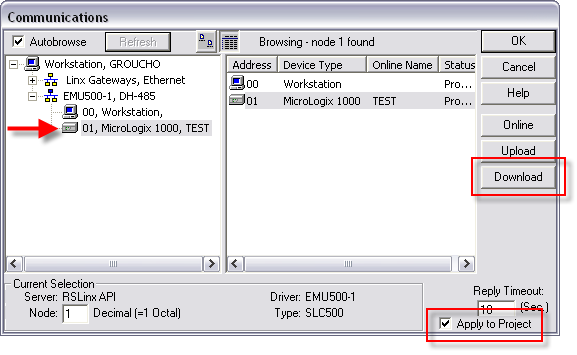

The SLC 5/03 and SLC 5/04 allow you to index from O0:0 to the last data file. Double-click within this field to enable a list box allowing you to select Yes to index anywhere from data file B3:0 to the end of the last declared data file. To maintain accuracy of this bit in your application, the instruction using bit S:4/3 (O:1/0 in this case) must be evaluated at least once every 79.999 ms.Ĭan be Yes or No. In the following example, bit S:4/3 toggles every 80 ms, producing a 160 ms clock rate. The application using the bit must be evaluated at a rate more than two times faster than the clock rate of the bit. You can use any individual bit of this word in your user program as a 50% duty cycle clock bit. It will begin incrementing from this value. It is incremented every 100 microseconds thereafter.Īpplication note: You can write any value to S:4. The value of this word is zeroed upon power up in the REM Run mode or entry into the REM Run or REM Test mode. This is illustrated in the example below for SLC 5/02 and higher processors.Īll 16 bits of this word are assessed by the processor. You can use any individual bit of this byte in your user program as a 50% duty cycle clock bit. This value is zeroed at powerup in the REM Run mode.

Only the first 8 bits (byte value) of this word are assessed by the processor. When an STI, high-speed counter, or Fault Routine interrupts normal execution of your program, the original value of this register is restored when execution resumes. This word indicates the element offset used in indexed addressing. When the controller sets this bit it indicates that the first scan of the user program is in progress.Įnter a value from -32768 to 32767. This information appears on the Main tab with the Structured Radix selected.Ĭan be Yes or No. If you write to status file data, make sure that you first understand the function fully. However, this information is seldom written to by the user program or programming device (unless you want to reset or clear a function). Depending on the type of processor you are using all of the fields explained below may not apply.įields on this display that are in gray are read-only. The status file lets you monitor how your operating system works and lets you direct how you want it to work. Some of the information in the Data File 2 can be modified and some of them are read only.There must only be ONE Data File 2 per processor.Here are some key characteristics of Data File 2. Data File 2 gives you an insight on the status and health of your PLC processor and its operating system / kernel. This article is about Data File 2 (Process Status File). As an analogy, imagine a drawer with 256 file folders and each file is your data file.ĭefault data file are created from 0 to 8 when you create a new program (assign process file name). It is basically a way for the PLC to organise its data so that user PLC logic can quickly and efficiently access the data. In PLC5 and SLC500, data are stored/organised in what they call as Data File. For the rest of us, we can use this article as a Wiki/Dictionary for RSLogix500 SLC Status. Make sure you are online with the controller if you have that setup. It would be easier to follow if you have a RSLogix500 connected to a PLC. I am publishing this just as a reference for all.


I don’t take credit for all these documents as they are straight from the RSLogix500 Help File.
RSLOGIX 500 MSG INSTRUCTION HOW TO
This one is going to be a very detail look into the RSLogix500 SLC Status mainly highlighting what each of the register means and how to use it to debug your logic.


 0 kommentar(er)
0 kommentar(er)
